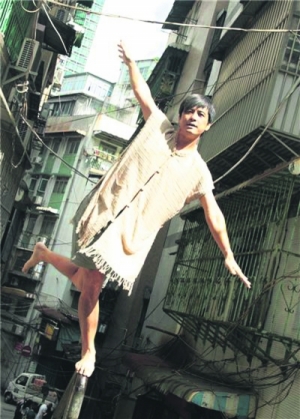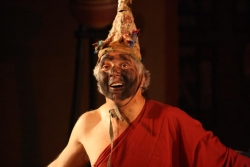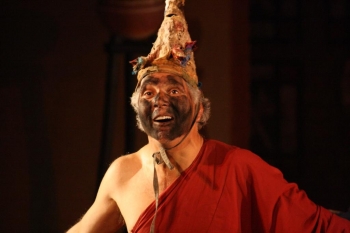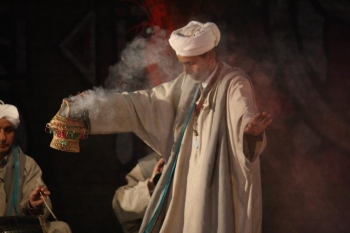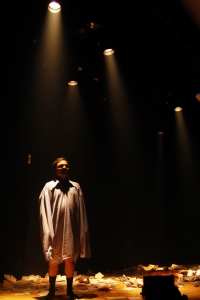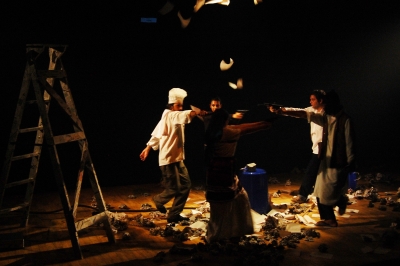2021年1月
AN AGE OF INNOCENCE—BEFORE / AFTER
I was 14 years old when I visited Kashmir with my parents and my younger sister for a holiday in the late 1980s. We were typical tourists from the Indian mainland and we did all the touristy things. We still have pictures from the holiday like my little sister posing in the traditional Kashmiri phiran. This will always be one of my favourite pictures of my sister. Yet when I revisit the memory now, I cannot but wonder at our naivety, or less euphemistically, at our ignorance. There we were, posing at a time, of what was the beginning of the end in Kashmir. Like most Indians outside Kashmir, we had been completely unconscious of the region's complex history, its troubled and vexed relationship with both India and Pakistan and its then nascent but simmering militancy.
My education on Kashmir happened much later in the late 1990s, by which time armed conflict had not only taken firm root in the doomed valley, but had also become a political weapon, adroitly exploited by far right Hindu leaders to reinvigorate their rallying cry to remove Article 370—the sacred covenant in the Indian Constitution between the Union of India and the State of Jammu and Kashmir, which basically set out the framework for the region’s accession to the newly formed dominion of India, soon after its Independence from the British in 1947. The act was done but the relationship was always queasy.
In 2019, the far-right government at the Centre in Delhi achieved a Machiavellian coup, which effectively read down Article 370 that took away the independent statehood of Jammu and Kashmir and turned it into a union territory of the Indian government. There was no consultation with the Kashmiri leaders who were simply put under house arrest and detained. The people of Jammu and Kashmir were completely caught off guard though there was visible activity (read army presence) in the region in the months leading to this legal legerdemain. It was as if overnight, the entire State was turned into an open prison as more Indian Army boots were deployed. The aftereffects of this move are still unfolding and will continue to dangerously reverberate.
As I write, 4G Internet continues to be denied to the people in the region; human rights abuses abound, among these several detentions and disappearances; the economy stands terribly affected, made further worse by the pandemic; and there is now even a deeper resentment towards the Indian government. There is a concerted PR exercise by the Indian government to show all is well but nothing can be farther from the reality on ground.
The righteousness of misplaced entitlement, certainly not new to New Delhi's dealings with the erstwhile State, had been increasingly in a feedback loop with militancy encouraged by Pakistan, starting in the late 1980s, while the ordinary people in Kashmir continued to suffer. The politics on Kashmir have been popularly played out in the domains of cultural nationalism and religion by India and Pakistan but geopolitics, with the need to have greater control over the region's natural resources and its borders are the key drivers of this bitter conflict, and in which China is more than invested too. While Pakistan has always been India's bête noire in the context of Kashmir, the face-off between China and India today is not least without territorial claims by both countries in the region with China clearly taking umbrage with the actions of the Indian government.
Kashmir’s history shows that it has been occupied for the longest, and its people have been consistently denied self-determination, but after 5th August 2019, it is well and truly, India's Palestine.
THE IMPREGNABLE FOURTH WALL
Narratives on Kashmir, whether on stage or off stage, tend to create an impregnable fourth wall. In the theatre, even when that wall is deliberately broken to convey a more interactive form of theatre with its audience, it tends to be peripheral and predictable when it comes to Kashmir. There is always the danger of running into clichés and of being superficial. It is not so much the actor but Kashmir that is separated on the other side of the stage, quite literally. This is then Kashmir's "public solitude" to borrow from Konstantin Stanislavsky—the ability to stay in the public/audience's eye but to act as if alone. While Stanislawsky developed this concept to aid the actors to focus on their selves and their interiority, forgetting that there were people watching them, in an ironic and cruel sense, this can be read as Kashmir’s ultimate tragedy.
This chasm between what the other India thinks of Kashmir and of Kashmir thinks of itself (or rather denied to think); to be a character but with no agency; to be centre stage yet silenced—these unresolvable paradoxes have also affected theatre on and of Kashmir.
Few theatre works from the Indian mainland have been able to convey informed and nuanced stories about Kashmir and Kashmiris therefore. There are some films and documentaries that have had a more powerful and lasting impact though.
It appears that in a live performance, it is not Kashmir then, but our own blinkered views and our inconsistencies, with our romanticised notions and our inability to recognise Kashmir in its own right that stands woefully exposed. It hence fails on nuance and gives us propaganda. It gives us torture but we do not truly share or understand the trauma.
It is far more difficult perhaps on stage to construct and portray a convincing narrative about Kashmir without making apparent the risks of an outsider's view, even if that person is an Indian from another part of the country.
Similarly, from within Kashmir, the challenges for younger and contemporary theatre groups to get their voices across are more formidable even when they are not shrill or censored. To begin a play at 2 pm and which must end before 5 pm is not a matter of convenience or choice for theatre makers and performers in Kashmir. It is just the safe thing to do before evening sets in, when the streets turn silent and where bombs and barbed wire are a matter of routine.
MYON VATAN (My Land) AND KASHMIR’S CULTURAL APPROPRIATION
In his poem Bi G’avi Ni Az (I Will Not Sing Today), the progressive and famous Kashmiri poet, Dinanath Kaul Nadim (1916-1988), wrote: “I will not sing—I will sing today no rose song, no song of the nightingale… When the thunder of guns tears out the tongue from the nightingale… For now warlord and the bureaucrat stand grit-about with an eye on my Kashmir…”
In 2020 before her budget speech, the Union Finance Minister Nirmala Sitharaman quoted another of Dinanath Kaul Nadim’s poems Myon Vatan (My Motherland) by deliberately addressing the poet as Dinanath Kaul without the adoption of his Muslim nom de plume “Nadim” that the poet had embraced for himself as a symbol of syncretism. The appropriation was all too evident and lame, if not outrightly chauvinistic and brazen, coming as it were after the dilution of Article 370.
Dinanath Kaul Nadim is also remembered for writing the first opera in Kashmiri, titled Bombur ta Yemberzal (Bumblebee and Narcissus). It was written during the 1950s, a time of upheaval in Kashmir, when its popular leader Sheikh Abdullah (whom the poet is said to have held in high regard) was arrested and the Bakshi government was formed. The opera is a parable that suggests while the Bumblebee and Narcissus aspire to live together, they cannot live together. At the time it was written, it could be read as a political comment on the relationship between New Delhi and Kashmir and which still endures. The Bollywood film Mission Kashmir (2000), which met with both commercial and critical success, borrowed from Bombur ta Yemberzal its popular Kashmiri song Bumbro Bumbro. Nadim who was inspired by communism and revolution got the idea in fact for his opera from a well-known Chinese folk tale Bai Mao Nu (White Haired Girl), which is about the daughter of a poor farmer whose family is exploited by a brutal landlord.
THE DYING MINSTRELS OF KASHMIR
Kashmir has a rich history and a pluralistic tradition but its ill-fated trajectory has been devastating. Its theatre, which is folk and modern, rural as well as urban, has also struggled to survive under not just the obvious hurdles but also because of a pernicious predicament writ large over the psyche of its people. Things have come to be normalised in Kashmir but have never been normal.
Delhi-based theatre director MK Raina who is a Kashmiri has been working with Bhand Pather performers in Kashmir as well as with urban actors. Bhand Pather is Kashmir’s folk theatre that has all but disappeared. Steeped in a Sufi tradition, Bhands of various types are played on community occasions and are a staple during the Urs, which is a memorial occasion on the death anniversary of a Sufi saint.
These performances like other folk performances in the Indian subcontinent lampoon and satirise while commenting on society and politics, even as they borrow from mythology. MK Raina adapted King Lear to Bhand Pather and called it Badshah Pather. This was also a time, MK Raina recalls, when militancy had caused the Bhands, who were wandering performers to literally shut shop, reducing them either to penury or turning them into labourers. In Shakespeare the Bhands found a way to make the story their own by using black humour.
More recently, performance artist Khursheed Ahmed who belongs to a family of Bhands, is using elements from Bhand Pather for his own works, giving the form a more contemporary voice and style. His specialisation in visual arts from Delhi’s Ambedkar University has helped him develop his language of performance art in which he has explored themes of identity and dissent.
Badshah Pather (King Lear)
PERFORMANCES IN THE CLOUD
Khursheed Ahmed has also been contributing to the Instagram page “abr_circle”, which has become a digital platform for cultural practitioners to support and commission digital works and performances, and is among the various new initiatives that are helping performers stage their works in COVID times. Abr in the Urdu language means cloud. In his performance, The Legendary Raat Krueal, Khursheed Ahmed, first slowly, and then frantically starts to build on the simple act of walking in a narrow, confined space. The piece develops its own rhythm and urgency as the music emerges reinforcing the psychological and the performative. The influence of Bhand Pather is visible and yet the piece reflects an aesthetic that is contemporary and whose ethos captures the claustrophobia and the anxiety of the trapped.
Salman Bashir’s Connecting on the Abr page is more direct in its reference to the aftermath of the reading down of Article 370. A simple act of calling and checking on family and friends from the mobile phone is now made impossible. Mom and Dad cannot be reached, nor can “Aaquib” or “Hina” or “Nahida”. Budgam, Phulwama, Srinagar, Baramulla…all unreachable. This is a simple yet evocative piece blending visual and digital art.
CALLING GOD
Mohammad Amin Bhat is one of Kashmir’s best-known contemporary writers. One of his plays Phone No. 786 became more widely known when the play was adapted for the film Hamid, directed by Aijaz Khan. It tells the story of a young boy whose father goes out to buy batteries one night and does not return. In the play the boy calls the number 786, which has a special reference in Islam, as the numeric form of the Arabic phrase “Bismillah al-Rahman al-Rahim”, which translates as “In the name of God, the Most Gracious, the Most Merciful”. The boy comes up with a formulation of a mobile number based on 786 and hopes that in calling the number, he can ask Allah to return his father. This is a story as much of a child coping with his father’s absence, as it is about Kashmir at the height of its militancy. In this burning and despairing atmosphere where the child’s mother is constantly making trips to the police station to inquire about her missing husband and identifying corpses, the young boy and the speaker at the other end of the phone, strike an uncanny bond, even as they are boxed by their identities and lead perilous lives.
There are other indigenous Kashmiri writers, poets, storytellers, artistes that need to be seen and heard. Senior theatre people from the late 1950s and 1960s include Moti Lal Kemmu, Radha Krishen Braroo, Ali Mohammad Lone, while Nissar Naseem and Manzoor Ahmad Mir are contemporaries with Mohammad Amin Bhat. Poetry and short stories have been the favoured forms. It took over a decade for Kashmir’s theatre to recover after it was destroyed in the insurgency. MK Raina spoke of the joy when Tagore Hall in Srinagar reopened in 2015. Now, the present administration wants to turn it into a cinema hall. Artists and activists have been protesting this. Tagore Hall’s history is intricately linked with the modern renaissance of theatre in Kashmir. It is a cultural icon that is being sought to be deliberately dismantled and is yet another devious attempt to erase spaces where public life and an assimilation of cultures can thrive.
KASHMIR KASHMIR / PARADISE LOST
For an outsider writing on Kashmir, playwright Ramu Ramanathan took an unusual route. A crumbling hotel is the protagonist of his play Kashmir Kashmir where a couple visiting Kashmir is staying to celebrate their second honeymoon. But this is just the exterior setting. With a superb narration by one of India’s best-known theatre doyens, the Late Satyadev Dubey, it is the various subtexts in the play that give glimpses into a wretched valley. Kashmir's sublimity, its breathtaking beauty—all the popular imagery of this “paradise on earth” is chipped away, little by little, with no end or repair in sight.
Director Mohit Takalkar of Aasakta Kalamanch that staged the play, in his Director’s Note said: “The play tickles my palate because of Ramu’s discordant writing,”, a telling metaphor that is Kashmir’s existential condition beyond just a matter of trope and style. Mohit Takalkar further adds: “…what makes the play interesting is, the methods of narrative construction and exploring the fictionality of the external world.”
Kashmir Kashmir (Photo: Suyash Tilak and Jay [Aperture India])
Kashmir Kashmir can be located in the tradition of the theatre of the absurd and in his telling of Kashmir. Ramu Ramanathan is acutely conscious of the very real absurdities and paradoxes that are replete in the construction of the Indian identity, of which Kashmir is a pronounced microcosm hinging on that famous line from Hamlet: “To be, or not to be, that is the question.”
In an interview with Ramu Ramanathan that I had for AICT-IATC's web journal Critical Stages, the playwright, while reflecting on India's "skin-deep democracy", talks of how Kashmir is one end of the spectrum, with the rest of the country not being far off. These words have proved to be prophetic, especially in these times.
THE MINORITY AND THE MAJORITY
The pre-Independence and post-Independence history of India that is intimately connected with the formation of Pakistan and later with the formation of Bangladesh is reflective of the complexity and the tensions surrounding the imagined as well as actual divisions between the perceived minority and the majority. The colonial rule in the subcontinent first articulated and enumerated these divisions by what was seemingly an innocuous Census exercise, but which has since been routinely exploited as a tool of communal propaganda and bigotry that thrives on narratives of otherness and difference. In the case of Kashmir this difference is exacerbated several times over. It is ideological, political, and also, just too personal.
Written by Karan Chaudhary and directed by Vivek TyaGi, Aksariyat Akliyat (which translates as Majority Minority) draws on these divisions to narrate Kashmir’s story that traverses its history to the present times. Staged by a group of young people in a very minimal but appealing way, Kashmir is both the subject and the object of this enterprise. At one level it may seem ambitious to dare this vast trajectory but on another level it is not so much the detail, or the nuance even, but rather the simple yet very effective storytelling foregrounded by its young actors that holds. We realise we know too much of this story already and we can overlook the clichés and the stereotypes, because what is being presented to us is simply an insurmountable and intractable tragedy.
Alternative Space Project's Aksariyat Akliyat
OF DJINNS AND GUNS
Bangalore-based Abhishek Majumdar's Kashmir trilogy has been one of his best-known theatre works featuring Rizwan, The Djinns of Eidgah, and Gasha. These are plays located in Kashmir and the settings are familial. These plays focus on relationships in a place that is coming apart. There is no more innocence. There are guns and djinns (ghosts). There is neurosis and there is flight. This is the most obvious then of what Kashmir looks like to those viewing it from the outside. In order to construct his narratives, the writer uses dramatic tension and familiar tropes. He plays with craft but the content remains in a sense cosmetic. There is also the danger of over simplification in spite of good performances and some imaginative stage design and improvisation. Nevertheless, the plays offer a visceral entry point into Kashmir.
Abhishek Majumdar's The Djinns of Eidgah
SICKLE, SARIYA AUR TALWAR
The chant for Azadi (freedom) which emerged in Kashmir and which has since captured national and international attention speaks of the unrealised dream of self-determination, of freedom. This is then the theatre of political protest. It means different things to different people from revolution to radicalisation. It is played out on the street and in campuses. It scares the powers that be but it continues to inspire and then are those who get caught in the crossfire.
Mohammad Muneem's Sickle, Sariya Aur Talwar
In Sickle, Sariya Aur Talwar, Mohammad Muneem of the band Alif, narrates an attack that happened to him with a sickle, an iron rod, and a sword. It feels like a story but is actually a piece of performance poetry in which the artist is trying to convince his mother that he did not do anything to provoke the attack but his mother would just not believe him. The mother is simply too scared for her son and no amount of caution can ever be enough.
Mohammad Muneem’s music and his songs throb with the cultural life of Kashmir and of the Kashmiris. His approach is of peace and of humanity, but in a region now permanently scarred, these remain more elusive and fragile than ever.
本網站內一切內容之版權均屬國際演藝評論家協會(香港分會)及原作者所有,未經本會及/或原作者書面同意,不得轉載。








